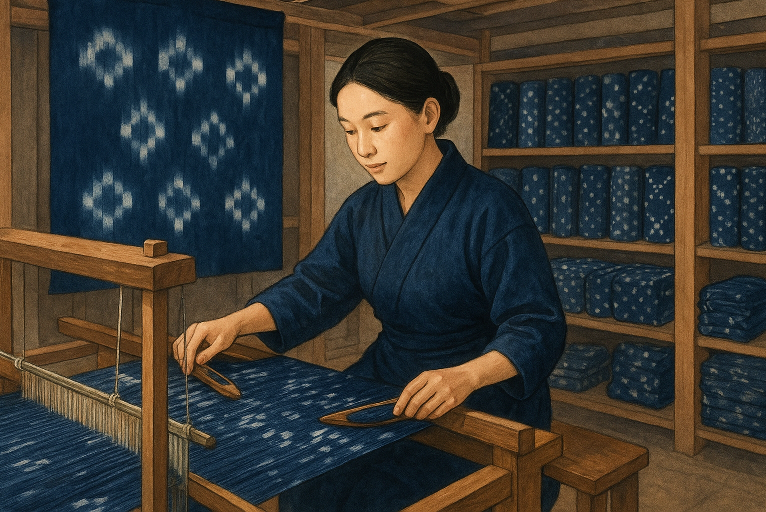
In the heart of Fukuoka Prefecture, the city of Kurume has quietly preserved one of Japan’s most beautiful textile traditions for over 200 years — Kurume Kasuri, a handwoven cotton fabric dyed in deep indigo blue.
The word kasuri means “blurred pattern,” referring to the distinctive, softly faded designs that appear on the cloth. Each pattern is created through a painstaking process of tying, dyeing, and weaving the threads by hand — a method that requires extraordinary precision and patience. No two pieces are ever exactly the same, making every bolt of fabric a true work of art.
This craft began in the early 19th century when an 11-year-old girl named Inoue Den discovered that by tying threads before dyeing them, she could create patterns within the weave. Her invention spread through Kurume, turning the town into one of Japan’s leading centers of cotton production.
Today, Kurume Kasuri continues to evolve. While traditional kimono and workwear remain beloved, many artisans now collaborate with fashion designers to create modern jackets, scarves, and interior fabrics that appeal to global audiences. The combination of natural indigo, handwoven texture, and minimalist beauty has captured the hearts of those seeking authenticity in an age of mass production.
Wearing or using Kurume Kasuri is more than enjoying a fabric — it’s carrying a story of craftsmanship, heritage, and timeless Japanese aesthetics, woven into every single thread.
久留米絣 ― 九州に息づく藍の糸の芸術
福岡県の中心部にある久留米市では、200年以上にわたって、日本で最も美しい織物の伝統のひとつである**久留米絣(くるめがすり)**が静かに受け継がれています。これは、深い藍色に染められた手織りの木綿布です。
「絣(かすり)」という言葉は、「にじんだ模様」を意味し、布の上に現れる独特の柔らかくぼやけたデザインを指します。それぞれの模様は、糸を手作業で括り、染め、そして織るという、非常に精密で忍耐を要する工程によって生み出されます。まったく同じものは二つと存在せず、どの反物もまさに芸術作品といえます。
この技法の始まりは19世紀初頭にさかのぼります。**井上伝(いのうえ・でん)**という当時11歳の少女が、糸を染める前に括ることで、織りの中に模様を作り出せることを発見しました。彼女の発明は久留米の地に広まり、この町を日本有数の木綿生産地へと発展させました。
今日でも、久留米絣は進化を続けています。伝統的な着物や作業着が今も愛されている一方で、多くの職人がファッションデザイナーと協力し、現代的なジャケットやスカーフ、インテリア用の布を制作しています。天然藍の色合い、手織りの質感、そしてミニマルな美しさの融合は、大量生産の時代にあって「本物」を求める人々の心を魅了しています。
久留米絣を身につけること、あるいは使うことは、単に布を楽しむこと以上の意味があります。それは、職人の技、伝統、そして時を超えた日本の美意識の物語を、一本一本の糸に込めて受け取るということなのです。
